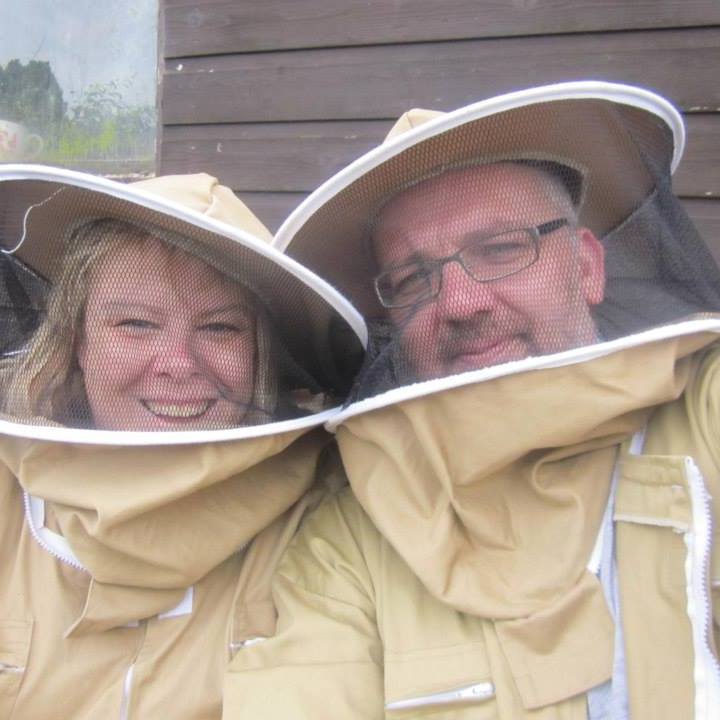
Ann’s tour of the south.
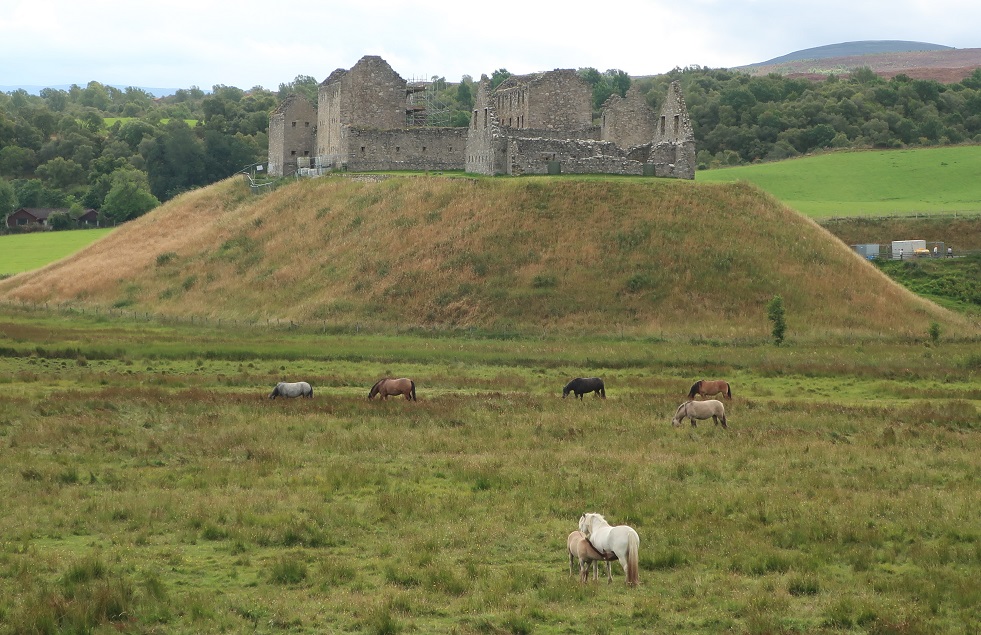
I’m away from home for a week visiting friends in Ayrshire and Dumfries & Galloway in the South of Scotland. It’s been quite an adventure so far. The car failed its MOT and was deemed unsafe to drive without extensive work that can’t be done till 19th September. I got over the disappointment and quickly resigned myself to taking the train hastily renewing my expired Senior Railcard which significantly reduced the cost of travel. It also reduced the stress of traveling down the A 9 and beyond with campervan-clogged roads.
However, it was an inauspicious start to the day in Nairn with the delayed arrival of the Aberdeen to Inverness train. I made it to Inverness and caught the Glasgow train with about a minute to spare. Breathing a sigh of relief, I sank into my forward-facing seat and relaxed to enjoyed the view for a bit. The heather was still fairly colourful but near the end of this season’s glory. I got stuck into Andy Pedley’s new publication, “Food Safety for Beekeepers” which I’m reviewing for you. I’d started taking notes and was in full swing when the bubble burst and we were all turfed out of the train at Pitlochry and left standing on the platform waiting for further information and alternative transport. Severe flooding caused tremendous disruptions to all transport around the area and it would take the bus over an hour to get into Perth on a roundabout route avoiding the worst of the flooding which was up to car doors in some places. Till our bus arrived we had to stand out in showers of rain which fortunately were light and not torrential like the flooding. A man standing close by kindly invited me to share his golf umbrella which was handy but left me hoping for short showers since the effort of making polite conversation was distracting. I was worrying about getting information through to Jackie so her afternoon wasn’t completely wasted waiting to collect me.
When we arrived in Perth it was more chaotic with no information from Scotrail at all, and it looked like we might be stranded there for a very long time. It felt like being in a flock of panicking sheep with anxious folk milling around trying to find information from officials who hadn’t a clue what was going on. I had to get out of the situation. I took a chance, with Victoria, another passenger from Inverness, and shared a taxi with someone going to Falkirk. After a kerfuffle in Falkirk finding the right platform, and lugging our cases over the bridge and back when we realised we were in the wrong side of the station, we got the train into Glasgow Queen St. I walked to Central Station to catch my train to Ayr but the distance seemed much farther than when I was last there 40 years ago. I was only 2 hours late arriving in Ayr and Jackie Elliott was there to meet me and drive me to her lovely home about 8 miles away. We sit down to have a cup of tea on arrival when we hear that the queen has just died. I’ll not forget where I was when I heard that momentous news.
Introduction.
I’m fast forwarding to my Annan destination because Phil had already prepared a guest blog which ties in with my visit to Oor Bees. I’ll be filling in the gaps next week and concluding with what I learned from visiting Jackie, Margaret Anne Adams and bee farmer Phil.
Thank you Phil for contributing to Beelistener, and to you and Lorraine for hosting me so well.
Oor Bees.
Firstly, we must thank Ann for asking us to write a guest blog for her fantastic Beelistener Blog. The blog is a must read for any beekeeper providing a great mix of interest, top tips, learning and inspiration. We were lucky enough to first meet Ann when we attended the Healthy Bees education courses which ran from 2018 – 2020. Ann was one half of the teaching team, so, having attended all 8 courses over the 3 years, we owe a lot of what we now know to Ann.
Who are Oor Bees?
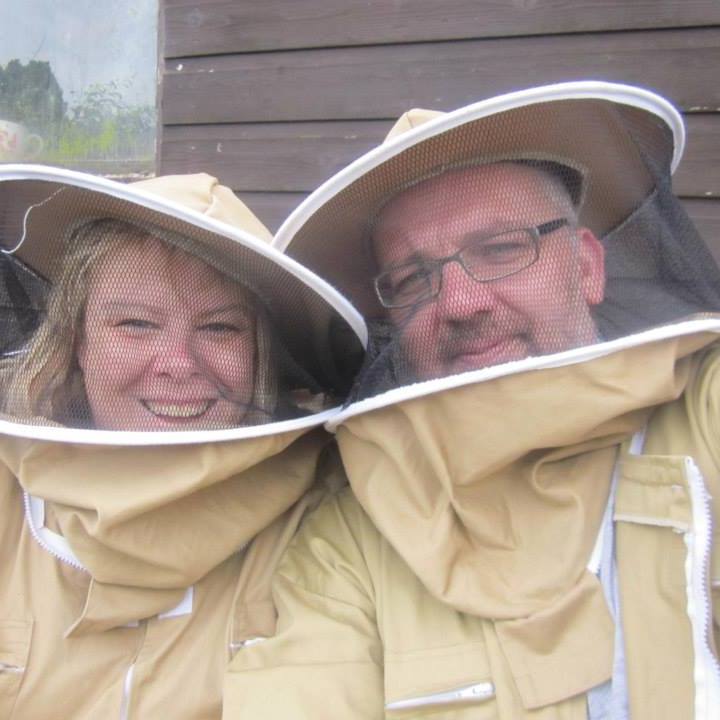
Oor Bees are Lorraine Johnston, Phil Collett and of course all the bees in our 50 or so colonies. Based in the South West of Scotland, we began beekeeping when we were lucky enough to get last minute places on the South of Scotland Beekeepers Association (SSBKA) taster day during May 2015. We were both immediately struck with ‘Bee Fever’ and signed up for their beginners’ course running through the rest of the summer and early autumn. We were very lucky to benefit from the knowledge, experience and enthusiasm of a range of SSBKA members who give up so much time to run these courses and hold regular members meetings. Local Associations are a vital resource for encouraging and nurturing beekeepers and we urge all beekeepers to get involved – the more you put in the more you get out.
https://www.facebook.com/groups/1376258162464520/
Getting started.
Starting with a SSBKA- supplied nuc in 2015, we quickly realised an out- apiary was a must and ended 2016 with 5 colonies over two sites. A familiar story for many beekeepers; we very quickly got carried away with our hobby and as we reached the end of the 2019 season. We were overwintering over 30 full colonies and 17 nucs with the intention of running around 50 production colonies from then on. As it stands now at the end of the 2022 season, that’s pretty much what we’ve managed to stick to.
Our intention has been to learn to manage 50 colonies with confidence and efficiency before considering any further expansion. We are very aware that different seasons throw up new challenges for beekeepers. One year it may be relatively easy to keep up with the bees and feel on top of things. The next may bring tremendous nectar flows and congested hives leading to lots of swarming. Or poor weather could make inspections difficult and see colonies needing fed. Managing 50 colonies and preparing for and attending the markets currently takes up much of my time during the summer months. Not only the practical side of managing them, but the planning and decision- making process still takes time. Until it becomes almost automatic, having more colonies could result in poor beekeeper performance leading to bees not being cared for as well as they should be.
How we manage Oor Bees.
Currently Oor Bees are kept on 6 separate apiaries grouped geographically in twos. Usually, each apiary has about 8 productive colonies. The number of inspections required at each apiary grows through the season as swarm control is carried out and nucs produced. Two apiaries can usually be comfortably inspected and dealt with in a day, more if needed and on days when not much action is required.
Forage & feeding.
We generally don’t have oil seed rape (OSR) near us so spring is about ensuring colonies have enough food stores and are in good condition for the main nectar flow. This can vary depending each year depending on weather so a supply of fondant is at the ready packed into tubs of approx. 750 g each for placing on top of any colonies that feel light to heft. Once put onto a hive, fondant should be checked every couple of weeks and more added if necessary. Hefting of hives is always a worthwhile process regardless of time of year as it gives the beekeeper a feel for what’s happening in the hive. Always ensure the colony isn’t strapped down, or doesn’t still have a heavy brick on the roof when hefting (we’ve all done it!) Most often our colonies are fine and don’t require fondant as they will have each been given approximately 14 kg of Invertbee in the autumn. We ensure that our colonies on a brood and a half system (one deep brood box and a shallow box) have plenty stores going into winter. However, some may be feeling a bit light going through March. This is a difficult time for bees as a small, aging, population of bees is trying to provide for an increasing brood nest. Time spent checking the weight of the hive and adding blocks of fondant is a small price to pay for helping colonies through this difficult period, especially if our South West Scotland climate isn’t favourable. Once the weather is improving to allow us to carry out inspections and the nectar flow started colonies are assessed and supers added. The balance of opening hives up and disturbing the bees or not at this time can be tricky.
Space & swarming.
This year colonies were already large on first inspection and most had two supers added straight away to give the bees space. Giving space is one of the main ways a beekeeper can try to put off or delay the swarming instinct of the bees. We have found as we’ve increased our stock of drawn comb, we are able to do this more easily and the timing of swarming is a bit later and more spread out making it easier to deal with.
Our preferred method of swarm control is the nucleus (nuc) method. So, once Oor Bees do begin to make swarm preparations, and on our regular 7- day inspections we find charged queen cells, we make a nuc up including the queen, 2 frames of brood and the bees on those frames and two frames of food including the bees on those frames. It is important to ensure there are no queen cells transferred to the nuc. Most of the time the nucs being made up will stay in the apiary they are made up in, so another couple of frames of bees are shaken in. This boosts the numbers of bees in the nuc as older bees will return to the parent hive once released from the nuc. It is because of this the nuc must not be fed for a day or two after opening or robbing is likely. If for any reason I have not been able to give a nuc sufficient stores to last, I will add fondant rather than syrup. The parent hive is left with one good quality open, charged queen cell the position of which is marked. After a week we check this cell is in good condition and remove all the new queen cells the colony will have produced. As the bees will have made emergency cells the frames have to be checked very carefully by shaking the bees of the frames. The frame with the chosen queen cell can be shaken upside down so no damage is down to the precious new queen in waiting. After this the bees cannot make any more queen cells until the new queen is laying. At this point her strong pheromones, and the beekeeper ensuring sufficient space with supers, will mean the colony does not swarm. If a queen cell is missed seven days after removing the queen the colony will almost undoubtedly swarm as the nuc method leaves a strong colony behind. Of course, they will likely swarm with the preferred queen from the chosen queen cell leaving your colony with potentially a smaller less suitable queen from an emergency cell, so small you missed it. So, this stage is one to be attentive to. If done well this method ensures a stock of strong young queens in your productive colonies which retain a strong foraging force throughout the season.
Nuclei.
The nucs produced can have many uses. They can be retained next to the parent hive. The original queen is a priceless back- up to be used to unite to the hive if the new queen fails. Alternatively, she can be removed and the bees united back without her to boost colony numbers. They can be sold on, or moved and used to requeen other failing colonies. Nucs are also great for drawing new, clean good quality comb. During 2021 many of our 6- frame poly nucs had 2 brood extensions on them and every week we could remove 2 deep frames from each, freshly drawn and filled with sealed honey.
The nuc method of swarm control does rely on finding the queen. Despite employing various queen finding tricks (most importantly patience, concentration and relaxation) this sometimes doesn’t happen so alternatives are needed. We use a few. Most often we’ll make up 2 nucs from the hive. No queen cells are transferred but care is taken to ensure both the two nucs and the parent hive are left with the means to requeen themselves, i.e., they have eggs. The two parts that are queen- less will start making emergency queen cells usually easily distinguished and telling us which of the three parts does have the queen. Of course, the queen- right part may also make queen cells in the form of fresh swarm cells! If this is the case at least the colony has reduced numbers and so the queen may be more easily found and removed. If this method is employed at our more distant apiaries, we tend to put travel screens on the nucs when they are made and bring them to an apiary close to home. This way the flying bees from the nucs don’t return to the main hive boosting its numbers and increasing the risk of it swarming if the queen was left there. The nucs can be checked after a couple of days where hopefully the queen will be found and normal swarm control service resumed. If both nucs contain emergency cells it is worth the return trip to the original hive to check if the colony has made fresh swarm cells. The likelihood of this can be reduced giving space so if drawn comb was available when making the nucs up as opposed to foundation this should be used.
Marketing the products.
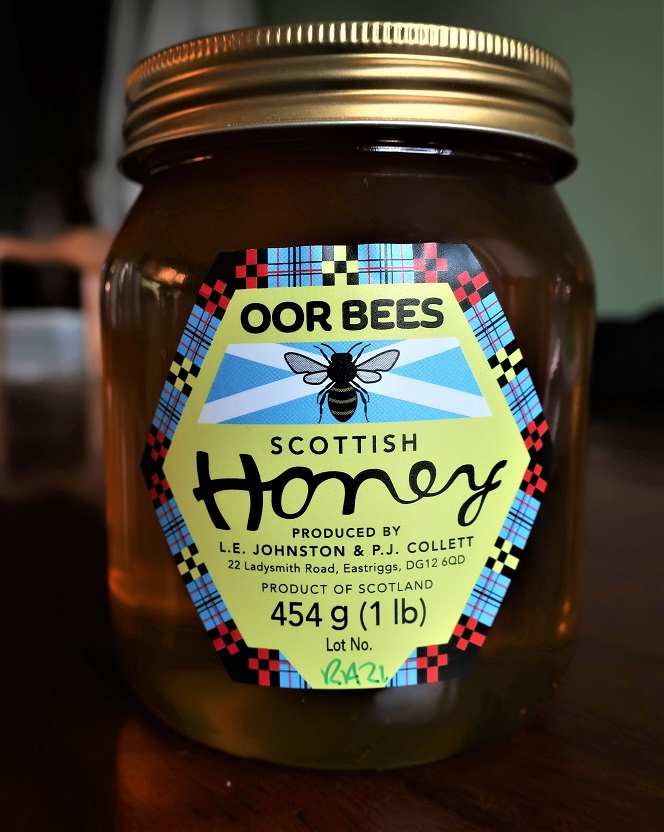
We currently supply two local shops and attend three farmers markets each month. As it stands our current rate of honey production is balanced with our rate of sales. We feel it is vital to ensure customers buying our honey don’t go disappointed so making sure we have enough to supply the shops and markets year-round is a must. Covid has disrupted the markets but establishing a regular pattern of attendance in the various towns so customers know when we will be there is also important. We were lucky that once we reached the stage of having enough honey to sell the local markets didn’t have a honey producer selling so they were delighted when we applied to join. There are a number of one- off markets that can be added in with big local agricultural shows and game fairs taking place.
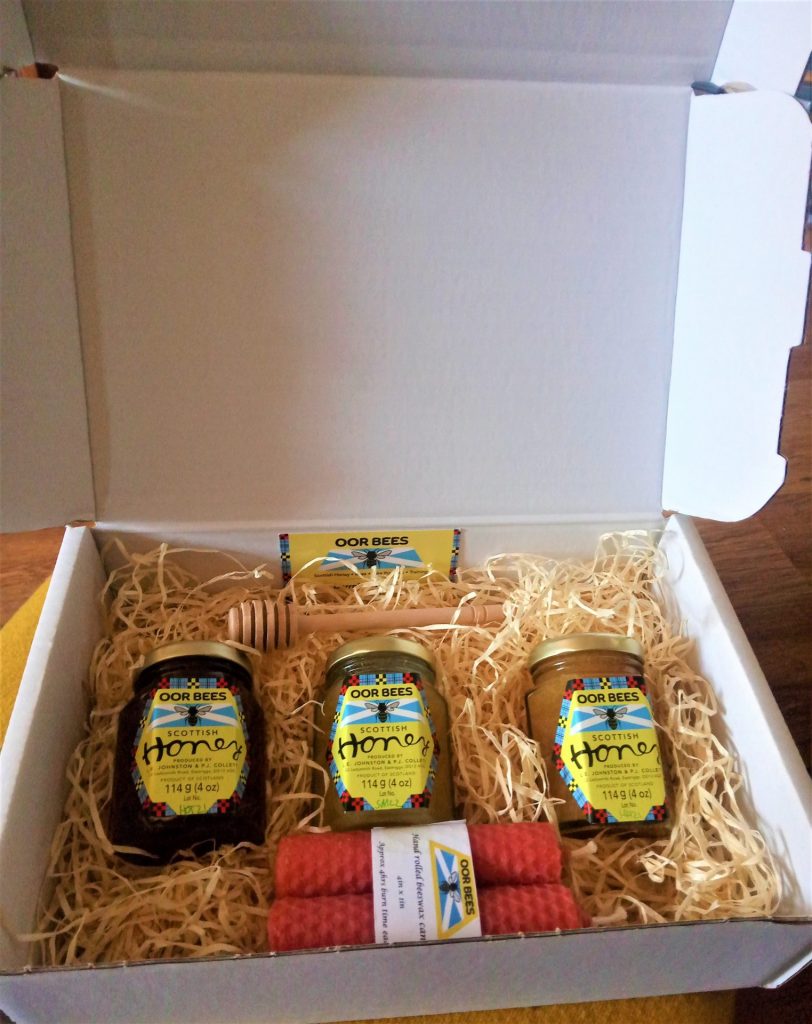
December is a big month with any number of extra opportunities to take a stall for Christmas markets. Gift packs are a big seller at these. There is a balance to be found between supplying shops and attending markets. Shops are needing a margin even it’s a small one so you are unlikely to get as much per jar selling to a shop. But delivering boxes to a shop is a lot quicker than standing at a stall all day. We enjoy the markets and they not only provide the opportunity to get a bit more per jar but also to add value in the way of gift jars, gift packs, candles and the occasional special product such as a chilli- infused honey. It is definitely interesting and revealing to speak to customers face to face. For example, the demand for heather honey and comb honey has been made clear! Our social media presence helps inform where we are and when and is also used to highlight the shops stocking our products.
What does future hold?
More bees…! More apiaries close to home could easily be looked after, the increased numbers would allow us to increase the number of shops we supply and allow us to attend larger one -off markets without fear of running out of honey for our regulars.
Queen rearing and nuc production. There is undoubtedly a demand for quality locally produced, locally adapted bees. Nuc production goes hand in hand with our current management methods but specific queen rearing will need a commitment in terms of equipment and time. Time- wise it does all seem to be happening at the same time in beekeeping so as with everything preparation and readiness is the key otherwise it’s likely to not happen. It’s important not to underestimate the time involved with selling nucs and queens as preparing for travel, moving to a collection point, and meeting customers all takes time, often when you’d rather be dealing with other pressing beekeeping issues.
Bee improvement is key to our management strategy and we tend to cull the worst stock and promote our best by rearing queens from our good stock. Record keeping is vital in beekeeping and we need to ensure each colony is pulling its weight! Our selection criteria for queens are for non-aggressive bees that are easy to work with but also have to include honey production.
Follow up.
Look out for next week’s blog when I’ll be taking you on a tour of Oor Bees and sharing some of the tips I learned from Phil.
